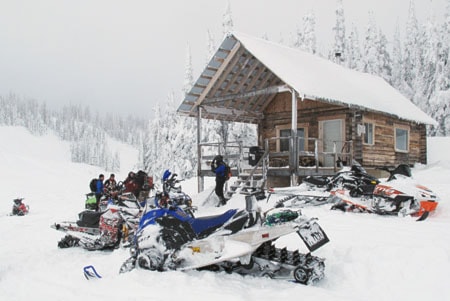New avalanche awareness signage around the province will give backcountry enthusiasts access to better information for evaluating avalanche risks, the Ministry of Natural Resource Operations announced Wednesday.
Avalanche awareness signs, mainly targeting snowmobilers, were posted at 23 highway locations and most of the 85 snow-mobile locations in the province, the minis-try said.
The signs warn of avalanche terrain and provide a telephone number and address to contact for up-to-date avalanche conditions. The ministry is also planning on install-ing new “Avaluator” (avalanche evaluator) signs at nine of the province’s most popular snowmobiling trail access sites, including Boulder Mountain and Frisby Ridge near Revel-stoke.
The signs will provide a map of the area that indicates the terrain risk in regards to avalanches.
“It’s important that outdoor enthusiasts have access to accurate and relevant information as they head into the backcountry,” said Steve Thomson, Minister of Natural Resource Operations.
“This new signage, including the new avaluator signage, will help people to recreate safely in the backcountry whether they are sledding, skiing, snowboarding or hiking.”
The signs are part of an ongoing effort by the province, local snowmobiling clubs and the Canadian Avalanche Centre (CAC) to address growing concerns about snowmobiling in the back-country.
Two particular events were a substantial catalyst to the progress being made today, according to CAC executive director Ian Tomm. The first of these was a Dec. 2009 report by the BC Coroners Service containing findings and recommendations on a death review panel convened to examine the 19 avalanche-related deaths involving snowmobilers in the winter of 2008-09. The report states that, while it is recognized a large number of snowmobilers managed to recreate safely in the backcountry, there was a growing gap in the level of avalanche awareness, preparedness, and the patterns of backcountry use between snowmobilers and skiers, who were more likely to engage in avalanche safety training.
The second event was another avalanche involving snowmobilers.
“On the heels of that report, the Boulder Mountain accident outside of Revelstoke happened on March 13, and those two events… created a significant catalyst for change,” says Tomm, explain-ing the coroner’s report has united all the stake-holders involved in this issue. “It’s a roadmap for change. The report contains 15 recommendations on what can be done to buck this trend, and… most of the recommendations are be-ing actively worked on right now.”(The report is avail-able at http://www.pssg.gov.bc.ca/coro-ners/publications/docs/death-review-panel-avalanche-snowmobile.pdf)
Eagle Valley Snow-mobile Club president Bruce Moores is encouraged by the progress made to educate sledders on the potential hazards of the back-country and make sure they are familiar with the terrain they’re riding on. He says terrain assessments have already been done by the province and, along with the avaluator signs, additional signage utilizing that terrain information (categorizing terrain as simple, challenging and complex) is being set up at the club’s cabins.
Brochures are also be-ing made up for distribution at the trailheads of the club’s riding areas.
“I think if we look at the huge gains that we’ve made over the summer, it’s been through close partner-ships with the snowmobiling clubs,” says Tomm.
